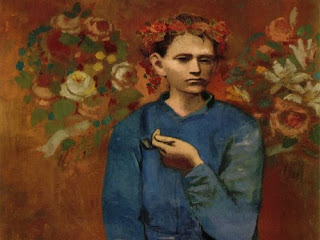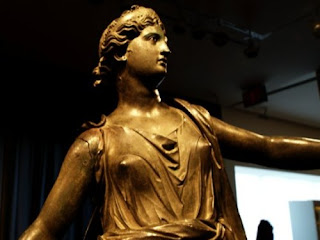Children are natural philosophers.
Childhood is the stage in life in which children are trying to explain the world by exploring and developing theories (for some, this way of thinking continues on into adulthood).
As a parent (and logician), I introduced philosophical thinking early on in my children's upbringing. While I did not present it as educational material (i.e., Hobbes theorized this or that and contributed to the world this or that), philosophizing became our "way" of exploring our thoughts about the world and our place in it.
My son (who turned 15-years old yesterday) and daughter (age 17) have been enjoying Pop Philosophy since elementary school (Star Wars & Philosophy, Harry Potter & Philosophy, The Matrix & Philosophy, Anime & Philosophy, Alice in Wonderland & Philosophy, Do You Think What You Think You Think, etc.). I read these books to them as if they were storybooks.
Socrates, Plato, Aristotle, Descartes... are like childhood characters with whom they identify according to their viewpoints on magic, time travel, and the future of technology ~ highly relevant subjects for any person interested in the space, time, location, possibility, and trajectory of their lives as well as the future of humankind.
Socrates, Plato, Aristotle, Descartes... are like childhood characters with whom they identify according to their viewpoints on magic, time travel, and the future of technology ~ highly relevant subjects for any person interested in the space, time, location, possibility, and trajectory of their lives as well as the future of humankind.
For parents or teachers interested in teaching philosophy to kids ~ even for those not trained in the field of philosophy ~ Pop Philosophy or general audience philosophical books present adults interested in fostering the minds of children unique opportunities from which to build lesson plans that can be written so that general comprehension skills, new SAT words, and creative writing activities (and more) can be introduced without the sole focus being placed on learning new skills. Kids are so enamored with the "Big Questions" we ask in life, that it rarely feels like schoolwork. In this sense, learning is not just fun, it is incredibly interesting and relevant.
Take for example, the Philosopher's Toolkit. The idea of passing along "tools" to kids is highly enticing, both for student and teacher. Telling kids that they will walk away smarter than 90% of the world's population is also BIG incentive for the "work" they will have to do in order to "philosophize."
Rather than tricking kids (something most tests are designed to do), I have developed an approach that makes learning so easy that kids instead utilize the material as their own. This encourages students to instead focus on the big questions during classroom debates and discussions. True thinking and participation earns kids "good grades" ... the comprehension just seems to go along with the experience. When kids are having fun and actively engaged, they form emotional attachments to the information. This results in "remembering" information much longer than traditional approaches yields... and without the stress.
I still grade their work, make corrections and present them with standard letter grades. However, I offer this as a transition from traditional pedagogical practices (something engrained into most teachers, parents, and students). When it comes to letter grades on transcripts, I grade according to participation and the ability to present new, logical, creative or otherwise funny thoughts on the material we study.
Personally, I believe in following our dreams first... pursuing Plan B second (i.e., go to school, get good grades in outdated subjects, go to university to specialize, learn how to organize, and follow through, so that one might "get a job" doing more of the same until one retires and if they are lucky, finally get a chance to paint, draw, write, sculpt, work on cars, or restore antiques in order to give their life deeper meaning).
I mention this because quality thinking and the ability to examine one's life are the two most important skills (in my opinion) a parent or teacher can pass along to the next generation of global citizens. With clear thinking follows better thoughts and actions, which leads to improved lives for everyone on the planet.
Rather than tricking kids (something most tests are designed to do), I have developed an approach that makes learning so easy that kids instead utilize the material as their own. This encourages students to instead focus on the big questions during classroom debates and discussions. True thinking and participation earns kids "good grades" ... the comprehension just seems to go along with the experience. When kids are having fun and actively engaged, they form emotional attachments to the information. This results in "remembering" information much longer than traditional approaches yields... and without the stress.
I still grade their work, make corrections and present them with standard letter grades. However, I offer this as a transition from traditional pedagogical practices (something engrained into most teachers, parents, and students). When it comes to letter grades on transcripts, I grade according to participation and the ability to present new, logical, creative or otherwise funny thoughts on the material we study.
Personally, I believe in following our dreams first... pursuing Plan B second (i.e., go to school, get good grades in outdated subjects, go to university to specialize, learn how to organize, and follow through, so that one might "get a job" doing more of the same until one retires and if they are lucky, finally get a chance to paint, draw, write, sculpt, work on cars, or restore antiques in order to give their life deeper meaning).
I mention this because quality thinking and the ability to examine one's life are the two most important skills (in my opinion) a parent or teacher can pass along to the next generation of global citizens. With clear thinking follows better thoughts and actions, which leads to improved lives for everyone on the planet.
I realize this approach might sound counterintuitive to what we have been taught about traditional learning, in particular when our present educational model promotes the exact opposite way of teaching, but my rationale for this is that I want kids to want to learn. I want them to question and have the tools necessary to argue, debate, imagine, wonder and ponder information logically and without bias (or at least know their biases). In a nutshell, I want them to enjoy learning.
In a world such as ours that is so vastly changing, it is more relevant to teach a child to "think well" than it is to fill their minds with facts and figures they quickly forget. Talk about a waste of everyone's time...
In a world such as ours that is so vastly changing, it is more relevant to teach a child to "think well" than it is to fill their minds with facts and figures they quickly forget. Talk about a waste of everyone's time...
Teaching philosophy in our home has turned into an opportunity to introduce new and exciting concepts and characters in what ends up being amazing discussions with new (or rather old) insights on life, technology, time travel, and all the subjects relevant to the era in which we live. The ease in which my kids find information in the books we read allows them to integrate information stress-free and utilize it to participate in more exciting discussions and activities in a way that it becomes the information naturally becomes their own.
Unfortunately, most of the philosophical books I'm referencing do not come with "lesson plans" to make it easier on parents or teachers who would otherwise have to write-up general comprehension questions in order to have a basic footprint to follow. Few people have or can make the time to do this. However, since I already do this, I thought I would share some of what I've created (for personal use) for those interested in teaching or exploring philosophical concepts with kids.
As you will see, the questions are simple and straightforward ~ almost "too" easy. But remember what's important here... encouraging young minds to "think" rather than "memorize"... and to use books and computers as "tools" to gather relevant information in order to make logically sound (or at least well-thought-out) decisions and choices.
Thinking and choosing well are two essential life skills that can vastly improve the quality of our lives and our children's futures. Sound thinking is, along with love and emotionally mature guidance and support, one of the best gifts we can give children.
As you will see, the questions are simple and straightforward ~ almost "too" easy. But remember what's important here... encouraging young minds to "think" rather than "memorize"... and to use books and computers as "tools" to gather relevant information in order to make logically sound (or at least well-thought-out) decisions and choices.
Thinking and choosing well are two essential life skills that can vastly improve the quality of our lives and our children's futures. Sound thinking is, along with love and emotionally mature guidance and support, one of the best gifts we can give children.



































.jpg)

.jpg)
.jpg)








.jpg)

